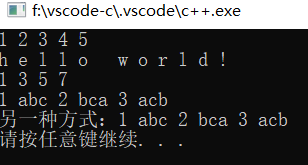C++11的for循环使用auto的新用法
for(auto a:vec)
{
cout<<a<<" ";
}
#include<bits/stdc++.h>
using namespace std;
int main()
{vector<int> vec;for(int i=0; i<10; i++){vec.push_back(i);}for(auto a:vec){cout<<a<<" ";}cout << endl;vector<int>::iterator it = vec.begin();for (it; it != vec.end();it++){cout << *it << " ";}system("pause");return 0;}

void printLN(T value)
{
cout << value <<" ";
}
for_each(vec.begin(), vec.end(), printLN);
for_each(iterator,iterator,callback);
前两个参数列表是遍历容器的迭代器,第三个参数是对应的回调函数
回调函数的原理都是将参数传递至相应的函数体,再进行操作
#include<bits/stdc++.h>
using namespace std;
template<typename T>
void printLN(T value)
{cout << value <<" ";
}
int main()
{vector<int> vec;for(int i=0; i<10; i++){vec.push_back(i);}for_each(vec.begin(), vec.end(), printLN<int>);system("pause");return 0;}

#include<bits/stdc++.h>
using namespace std;int main()
{//arrayint array[] = {1, 2, 3, 4, 5};for(auto a:array){cout << a << " ";}cout << endl;//stringstring str = "hello world!";for(auto b:str){cout << b << " ";}cout << endl;//vectorvector<int> vec = {1, 3, 5, 7};for(auto c:vec){cout << c << " ";}cout << endl;//mapmap<int, string> mymap = {{1, "abc"}, {2, "bca"}, {3, "acb"}};for(auto d:mymap){cout << d.first << " " << d.second << " ";}cout << endl;cout << "另一种方式:";for (map<int, string>::iterator it = mymap.begin(); it != mymap.end(); it++){cout<< it->first<<" "<<it->second<< " ";}cout << endl;system("pause");return 0;}













)






